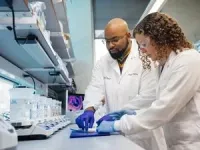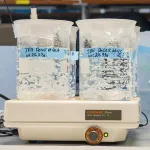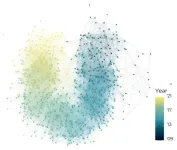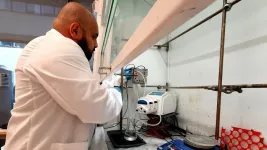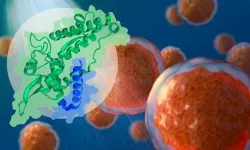(Press-News.org) An injectable hydrogel can mitigate damage to the right ventricle of the heart with chronic pressure overload, according to a new study published March 6 in Journal of the American College of Cardiology: Basic to Translational Science.
The study, by a research team from the University of California San Diego, Georgia Institute of Technology and Emory University, was conducted in rodents. In 2019, this same hydrogel was shown to be safe in humans through an FDA-approved Phase 1 trial in people who suffered a heart attack. As a result of the new preclinical study, the FDA approved an investigational new drug application for the Emory and Georgia Tech researchers to start a clinical trial with the hydrogel in pediatric patients in the coming months, once institutional approvals are received.
In this case, the injectable hydrogel is intended for children born with a condition that leaves them with an underdeveloped, nonfunctional left ventricle. The disorder, known as hypoplastic left heart syndrome, comprises less than 4 percent of congenital heart defects. But it is responsible for 40 percent of deaths associated with heart defects in newborns. Patients with the disorder have a 35 percent survival rate.
Current treatments consist of a series of three open heart surgeries all before the patient’s 5th year of life that reroutes oxygenated blood supply to the right ventricle. Pediatric patients who survive into childhood after surgery also receive medication and physical therapy, as well as a special diet. But this palliative surgery comes at a cost. In a healthy heart, the right ventricle’s job is to pump blood to the lungs; a job that entails dealing with blood at lower pressure and lower volume. When the right ventricle is forced to pump blood to the whole body, it develops several maladaptive traits, including overly large muscle and scarring. Eventually, the right ventricle begins to fail and patients will need a heart transplant.
“To the best of our knowledge, it’s the first time that an injectable biomaterial therapy has been evaluated to mitigate right ventricular heart failure,” said Jervaughn D. Hunter, the paper’s first author, who hails from Port Gibson, MS and earned his Ph.D. in the Shu Chien-Gene Lay Department of Bioengineering at UC San Diego.
In the rodent study, injecting the hydrogel into the right ventricle improved function and allowed the heart to tolerate increased blood pressure and volume. The treatment also slowed down the rate of tissue scarring and maladaptive muscle growth. The hope is that the hydrogel injection will increase the amount of time the patient’s heart functions.
“This isn’t a cure, but our goal is to prolong a patient’s life,” said Karen Christman, a bioengineering professor at UC San Diego and the paper’s corresponding author.
The treatment could also dramatically improve the patients’ quality of life, allowing better cognitive function and growth.
“They might be able to wait until they can get on an adult heart transplant list,” said Michael E. Davis, one of the paper’s senior authors and director of the Children’s Heart Research and Outcomes (HeRO) Center at Children's Healthcare of Atlanta and Professor of Biomedical Engineering at the Georgia Institute of Technology and Emory University School of Medicine.
The hydrogel is made from cardiac extracellular matrix that is stripped of the cellular content through a cleansing process; dried and milled into powder form; and then liquefied into a fluid that can be easily injected into the heart. Once it hits body temperature and pH, the liquid turns into a semi-solid, porous gel that encourages the patient’s own cells to repopulate areas of damaged cardiac tissue and to improve heart function.
Positive results
Preclinically, the treament’s effects were first seen two weeks after injection.
Researchers in Christman’s lab prepared the hydrogel with tissue from both the right and left ventricles of the pig hearts. Interestingly, tissues on each side of the heart differ vastly.
Hydrogels from either side of the heart improved systolic function–the heart’s ability to pump blood. They also reduced heart muscle growth and scaring while prompting arteriole formation and growth. But overall, hydrogel derived from left-ventricle tissue was more effective. That’s likely because the hydrogel derived from right-ventricle tissue is richer in type 1 collagen, which may have led to the enhanced inflammatory response seen in the RV hydrogel treated group.
The injected hydrogel also affected gene expression, specifically pathways related to cardiac repair, including the development of the circulatory system, muscle structure and vasculature, as well as regulation of immune response and cellular response to oxygen-containing compounds.
Next, Children's Healthcare of Atlanta, the children's hospital collaborating with Georgia Tech and Emory will start recruiting for a clinical trial investigating the treatment’s efficacy in newborns with hypoplastic left heart syndrome.
Funding for the research came in part from the National Institutes of Health National Heart, Lung and Blood Institute.
Myocardial Matrix Hydrogels Mitigate Negative Remodeling and Improve Function in Right Heart Failure Model
Jervaughn D. Hunter, PhD, Joshua M. Mesfin, BS, Tanzeel Ahmed, BS, Alexander Chen, BS, Kate Reimold, Arielle Hancko, BS, Rebecca L. Braden, MS, Karen L. Christman, PhD: Shu Chien-Gene Lay Department of Bioengineering, University of California San Diego
Michael E. Davis, PhD, Wallace H. Coulter Department of Biomedical Engineering, Georgia Institute of Technology and Emory University
END
This injectable hydrogel mitigates damage to the right ventricle of the heart
The material will be tested in a clinical trial in pediatric patients in coming months
2024-03-06
ELSE PRESS RELEASES FROM THIS DATE:
Giant dinosaur was “heron from hell,” not a deep diver, says new analysis
2024-03-06
For years, controversy has swirled around how a Cretaceous-era, sail-backed dinosaur—the giant Spinosaurus aegyptiacus—hunted its prey. Spinosaurus was among the largest predators ever to prowl the Earth and one of the most adapted to water, but was it an aquatic denizen of the seas, diving deep to chase down its meals, or a semiaquatic wader that snatched prey from the shallows close to shore?
A new analysis led by paleontologists from the University of Chicago reexamines the density ...
New deep-sea worm discovered at methane seep off Costa Rica
2024-03-06
Greg Rouse, a marine biologist at UC San Diego’s Scripps Institution of Oceanography, and other researchers have discovered a new species of deep-sea worm living near a methane seep some 50 kilometers (30 miles) off the Pacific coast of Costa Rica. Rouse, curator of the Scripps Benthic Invertebrate Collection, co-authored a study describing the new species in the journal PLOS ONE that was published on March 6.
The worm, named Pectinereis strickrotti, has an elongated body that is flanked by a row of feathery, gill-tipped appendages called ...
Nanosurgical tool could be key to cancer breakthrough
2024-03-06
The high-tech double-barrel nanopipette, developed by University of Leeds scientists, and applied to the global medical challenge of cancer, has - for the first time - enabled researchers to see how individual living cancer cells react to treatment and change over time – providing vital understanding that could help doctors develop more effective cancer medication.
The tool has two nanoscopic needles, meaning it can simultaneously inject and extract a sample from the same cell, expanding its potential uses. And the platform’s high level of semi-automation has sped ...
Genetic mutation in a quarter of all Labradors hard-wires them for obesity
2024-03-06
New research finds around a quarter of Labrador retriever dogs face a double-whammy of feeling hungry all the time and burning fewer calories due to a genetic mutation.
This obesity-driving combination means that dog owners must be particularly strict with feeding and exercising their Labradors to keep them slim.
The mutation is in a gene called POMC, which plays a critical role in hunger and energy use.
Around 25% of Labradors and 66% of flatcoated retriever dogs have the POMC mutation, which researchers previously showed causes increased interest in food ...
MIT scientists use a new type of nanoparticle to make vaccines more powerful
2024-03-06
CAMBRIDGE, MA -- Many vaccines, including vaccines for hepatitis B and whooping cough, consist of fragments of viral or bacterial proteins. These vaccines often include other molecules called adjuvants, which help to boost the immune system’s response to the protein.
Most of these adjuvants consist of aluminum salts or other molecules that provoke a nonspecific immune response. A team of MIT researchers has now shown that a type of nanoparticle called a metal organic framework (MOF) can also provoke a strong immune response, by activating the innate immune system — the body’s first line of defense against ...
A noninvasive treatment for “chemo brain”
2024-03-06
CAMBRIDGE, MA -- Patients undergoing chemotherapy often experience cognitive effects such as memory impairment and difficulty concentrating — a condition commonly known as “chemo brain.”
MIT researchers have now shown that a noninvasive treatment that stimulates gamma frequency brain waves may hold promise for treating chemo brain. In a study of mice, they found that daily exposure to light and sound with a frequency of 40 hertz protected brain cells from chemotherapy-induced damage. The treatment also helped to prevent memory loss and impairment of other ...
Film festivals are becoming more diverse in several ways, new study reports
2024-03-06
A group of Tallinn University researchers has published an innovative study that sheds light on the intricate dynamics of the global film festival circuit, revealing insights into diversity and public value creation within the industry. The research demonstrates that festival programming has become more thematically diverse, and the inclusion of films by women creatives has increased between 2012–2021.
The study “Quantifying the global film festival circuit: Networks, diversity, and public value creation,” published open access in the PLOS ONE journal, provides a comprehensive analysis of over 600 film festivals worldwide, spanning a period ...
New hydrogen producing method is simpler and safer
2024-03-06
Researchers in Sweden unveiled a new concept for producing hydrogen energy more efficiently, splitting water into oxygen and hydrogen without the dangerous risk of mixing the two gases.
Developed at KTH Royal Institute of Technology in Stockholm, the new method decouples the standard electrolysis process for producing hydrogen gas, which splits water molecules by applying an electric current. In contrast with prevailing systems it produces the resulting oxygen and hydrogen gases separately rather than simultaneously in the same cell, where they need to be separated by membrane barriers
That separation eliminates the possibility of the gases mixing with the risk of explosions, says ...
Studying the relationship between cancer-promoting proteins
2024-03-06
By Simonne Griffith-Jones, Predoctoral Fellow, EMBL Grenoble
Researchers from the Bhogaraju Group at EMBL Grenoble have gained new insights into how a cancer-relevant family of proteins bind their targets. The results of the study, published in The EMBO Journal, could potentially help in the development of drugs against certain chemotherapy- and radiotherapy-resistant cancers.
The Melanoma Antigen Gene (MAGE) family consists of more than 40 proteins in humans, most of which are only present in the ...
UTA educating schoolchildren about solar eclipse
2024-03-06
The University of Texas at Arlington has received a grant from the National Science Foundation (NSF) to support educational activities related to the upcoming eclipse.
UTA faculty and graduate students are visiting elementary, middle and high schools in the DFW area in March to give talks to about 4,000 students explaining the natural phenomena occurring during the eclipse and the physics behind it. UTA will also provide special eclipse glasses for students to use to avoid eye damage.
The $50,000 grant will also provide for about 1,500 students to take field trips to the UTA Planetarium, one of the three largest in Texas, to learn ...
LAST 30 PRESS RELEASES:
Exposure to natural light improves metabolic health
As we age, immune cells protect the spinal cord
New expert guidance urges caution before surgery for patients with treatment-resistant constipation
Solar hydrogen can now be produced efficiently without the scarce metal platinum
Sleeping in on weekends may help boost teens’ mental health
Study: Teens use cellphones for an hour a day at school
After more than two years of war, Palestinian children are hungry, denied education and “like the living dead”
The untold story of life with Prader-Willi syndrome - according to the siblings who live it
How the parasite that ‘gave up sex’ found more hosts – and why its victory won’t last
When is it time to jump? The boiling frog problem of AI use in physics education
Twitter data reveals partisan divide in understanding why pollen season's getting worse
AI is quick but risky for updating old software
Revolutionizing biosecurity: new multi-omics framework to transform invasive species management
From ancient herb to modern medicine: new review unveils the multi-targeted healing potential of Borago officinalis
Building a global scientific community: Biological Diversity Journal announces dual recruitment of Editorial Board and Youth Editorial Board members
Microbes that break down antibiotics help protect ecosystems under drug pollution
Smart biochar that remembers pollutants offers a new way to clean water and recycle biomass
Rice genes matter more than domestication in shaping plant microbiomes
Ticking time bomb: Some farmers report as many as 70 tick encounters over a 6-month period
Turning garden and crop waste into plastics
Scientists discover ‘platypus galaxies’ in the early universe
Seeing thyroid cancer in a new light: when AI meets label-free imaging in the operating room
Neutrophil-to-lymphocyte ratio may aid risk stratification in depressive disorder
2026 Seismological Society of America Annual Meeting
AI-powered ECG analysis offers promising path for early detection of chronic obstructive pulmonary disease, says Mount Sinai researchers
GIMM uncovers flaws in lab-grown heart cells and paves the way for improved treatments
Cracking the evolutionary code of sleep
Medications could help the aging brain cope with surgery, memory impairment
Back pain linked to worse sleep years later in men over 65, according to study
CDC urges ‘shared decision-making’ on some childhood vaccines; many unclear about what that means
[Press-News.org] This injectable hydrogel mitigates damage to the right ventricle of the heartThe material will be tested in a clinical trial in pediatric patients in coming months

